ALAN HOVORKA
Stevens Point Journal
STEVENS POINT, Wisconsin: Sarena Melotte could see past the crumbling home, its inside painted Pepto-Bismol pink when she saw the steep, curved, ebony staircase of the 19th-century villa that’s almost as old as Stevens Point.
“It was just something that just spoke to me,” she said. “I knew where everything was going to be.”
The home at 1665 Main St. is just 17 years younger than Stevens Point’s 1858 founding year. The story may have ended in the rubble if Melotte and Bill Schierl, who are married and live in the Portage County town of Carson, hadn’t purchased Price Claflin’s 1875 home in April 2016 after it sat abandoned for more than a decade.
Claflin House, which sits on one of the city’s most visible and central intersections, the southwest corner of Main and Division streets, has found a renewal three years later as a short-term rental on Airbnb.
“We didn’t want such a prominent corner to be an empty lot or something else,” Melotte said of the home they bought for about $40,000.
Wendell Nelson, a retired archivist with the Portage County Library, knows Stevens Point’s old homes. He wrote the book on them, “Homes That Grew: A Guide to Houses of Stevens Point”. Nelson’s 2014 book dedicates a one-page description to 200 homes in Stevens Point and notes their owners and when and how they were built.
Claflin’s home can be found in its pages and a more detailed account of the home’s history appeared in a guest series Nelson wrote for the Portage County Gazette in 2016, which cites historical documents and newspaper articles from the Gazette and the Stevens Point Journal.
Every home has a story. Any good story has ups and downs, heroes and villains and everything between, Nelson told the Stevens Point Journal.
Price Claflin wandered north to central Wisconsin by way of Oconomowoc in 1868 as he traveled a rags-to-riches path as a jeweler that bore fruit in Stevens Point.
Claflin started small as a jeweler, occupying a bench in an existing store. By 1875, Claflin found enough success in Stevens Point to own one of the region’s largest jewelry stores, which also sold musical instruments, Nelson wrote.
Stevens Point’s history, like that of many of the cities and towns along the Wisconsin river, stems from pine forests and the people who clear-cut them in the 19th century. Claflin’s success speaks to the strength of the city’s lumber economy at the time, Nelson said.
Claflin built his two-story Main Street villa on a quarter-acre lot. He expanded the Italianate-style home in 1883, Nelson wrote. The home today occupies more than 12,000 square feet.
He sold his business to his apprentices in 1886 as he began to dabble in real estate speculation, moving to Knoxville, Tennessee, in 1887 and later to Washington, DC, at an unknown date.
His home sold in 1888 to Henry Martin, a local businessman and city official. Martin, a Yale graduate, came to Stevens Point in 1884, creating a lumber and planing mill joint stock company with his father-in-law. He served a two-year term as a member of the Stevens Point City Council, one year as mayor and two years as fire chief.
Martin sold the home to Peter Kelly in 1897, a year before Martin died in 1898, Nelson wrote.
Unlike Claflin, Kelly never quite saw riches.
Kelly spent years bouncing from job to job in efforts to make it big. He faced mounting debt, however, as his latest venture into a funeral parlor and furniture business, Kelly Furniture and Undertaking Co., began failing from about 1903 to 1905. He resorted to taking money from St. Stephen’s Catholic Church sometime around 1905, where he served as treasurer, Nelson wrote in 2016. The church’s priest discovered the missing money and demanded Kelly repay St Stephen’s.
The church announced his misdeeds during a Sunday public announcement January 15, 1905, when he failed to make the payment. Kelly did not attend, opting to stay home. He died that day. Newspaper accounts attributed his death to a heart condition.
By the time Kelly died, Stevens Point’s economy had diversified to include a university campus, paper mills and railroad and insurance companies. Another self-made man would join the ranks of owners of Claflin House, Nelson said. John Martini, a German immigrant, rose to prominence near the end of the 19th century in Stevens Point as he built the Alhambra building at 1140 Main St. in 1896 and operated the saloon there.
Martini’s ownership marked another key milestone in the home’s history in 1913 with its first extensive remodel since Claflin first expanded it in 1883. Most notably, he knocked down a partition to expand the home’s large parlor room and added a fireplace.
Martini died in 1921 and the home changed hands for some 40 years until Roman Lukasavicz bought it in 1960 and converted it into seven apartments as the baby boomers came of age and the city’s demand for housing increased, Nelson said. The University of Wisconsin-Stevens Point had transitioned from a teacher’s college into a full-fledged state university by then. Darwin Whitman bought the home in 1975.
Homes often become apartments late in their lifespan, especially in university towns, fueling urban decay, Nelson said. However, the home was left vacant starting in 2004 until Melotte and Schierl bought it in 2016, a 12-year period of disuse that did more harm to the building than being an apartment did.
Nelson said squatters and the elements rushed the decay during the home’s vacancy. A fire was ignited inside the upstairs at one point, the roof was on the verge of collapse, a tree was growing out of the gutters and it was filled with several large trash bins worth of garbage, Melotte said.
“We want it to stand for another 100 years.”
Restoring a home in such a dilapidated state wasn’t an easy task, Melotte said.
They had no original blueprints and a century-and-a-half’s worth of changes made restoring the home more difficult. What could be restored? What had to be torn out? What was even original? Melotte and Schierl focused on restoring the house while converting it from apartments, which led to a modern take on the old home that fuses aspects of each decade into the design of the rooms.
“I think they’ve done well in making some compromises but also staying close to the original,” Nelson said.
Walking in through the front door that captured Melotte’s imagination, visitors see the preserved ebonized staircase contrasted by the home’s original hardwood floors paired with oak trim. To the left sits the narrow, yet sprawling, mission-style or bungalow-style parlor room with a fireplace, piano and original leaded windows.
The parlor connects to an intimately-modelled den painted monochrome blue, filled with brown leather furniture and a liquor cabinet. The parlor also leads to the dining room, where the couple had recycled trusses from the home converted into a dining table, and the kitchen with its ceramic tiled walls, butcher block island and exposed brick from an old coal chimney.
“We wanted it to keep its historical significance but inside we didn’t want it to feel like a time capsule,” Schierl said.
Melotte and Schierl redid the basement to emphasize a collaborative, intimate space with low-level lighting and exposed brick.
The upstairs contains four bedrooms, each with a bathroom and aesthetic style, and Melotte’s crowning jewel: a solarium and terrace. The bedrooms come with all the amenities of a luxury hotel, including king-size beds, double sinks, showers, TV, floor-to-ceiling windows, white-noise machines and individual climate controls.
The solarium is Melotte and Schierl’s personal touch on the home. Every owner before them altered the home in some way and this was their approach. The solarium sits on the west side of the house toward the Wisconsin River, where it catches the sunset on a clear day.
“I feel different eras left their mark on it and we’ve enhanced those pieces. Here, I feel like we’ve made our imprint on the home and what we envisioned in this space,” Melotte said.
The couple’s work on the home includes a push toward energy efficiency and locally sourced labor and products. The couple installed new roofing, radiant heat and ductless air conditioning and heating.
Bookings for the short-term rental come through the Claflin House website and Airbnb – but Melotte said about two-thirds of the clientele come through Airbnb.
The home’s basic rental package requires a two-night stay and two-room minimum, which costs about $550, Schierl said.
Melotte said their typical guests booking the home, which hosts up to 10 people, including people coming for events like UWSP hockey, families attending the American Suzuki Institute in the summer, local businesses hosting retreats and families hosting reunions and other gatherings. Their weekends are booked on any given month, she said.
The couple, according to property tax records, but at least $440,000 into the home to make sure it has a life well into this century.
“It stood for 143 years but we want it to stand for another 100 years when we’re dust,” Melotte said. AP







